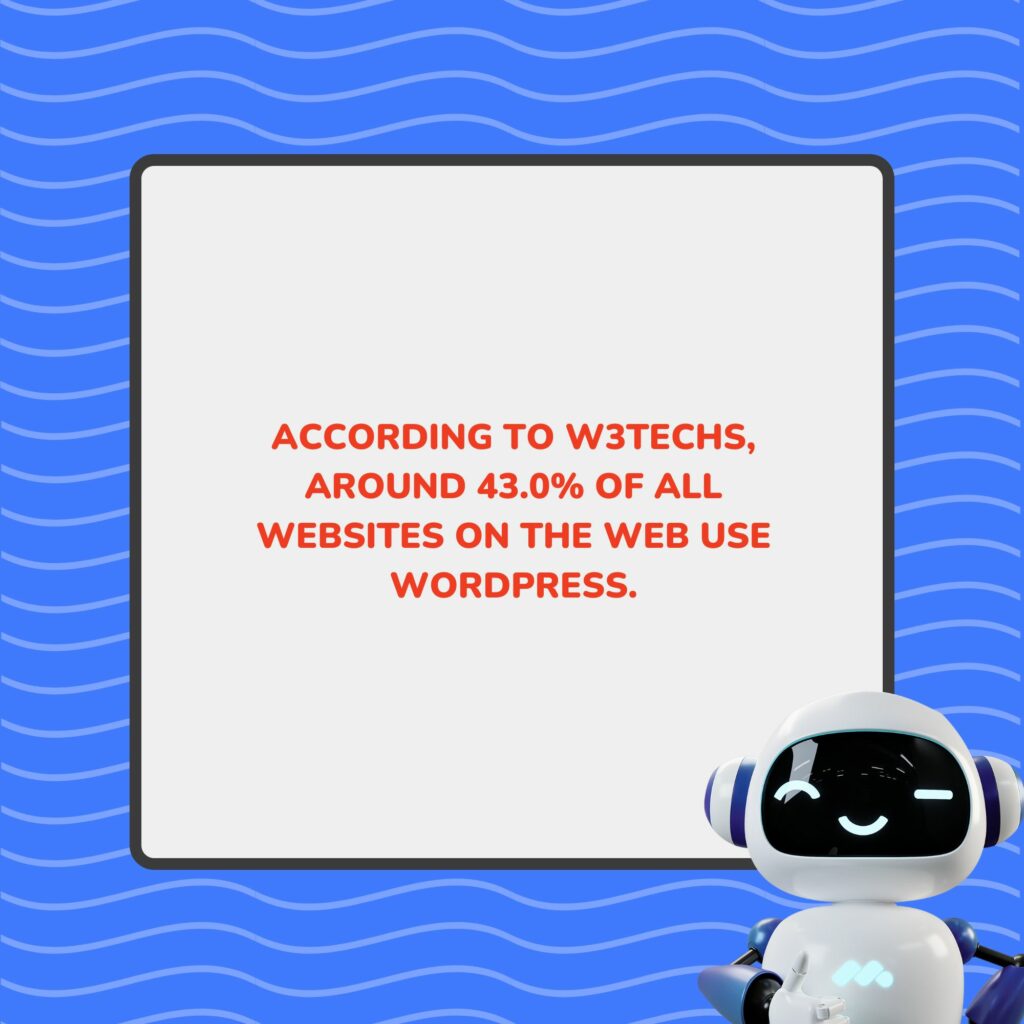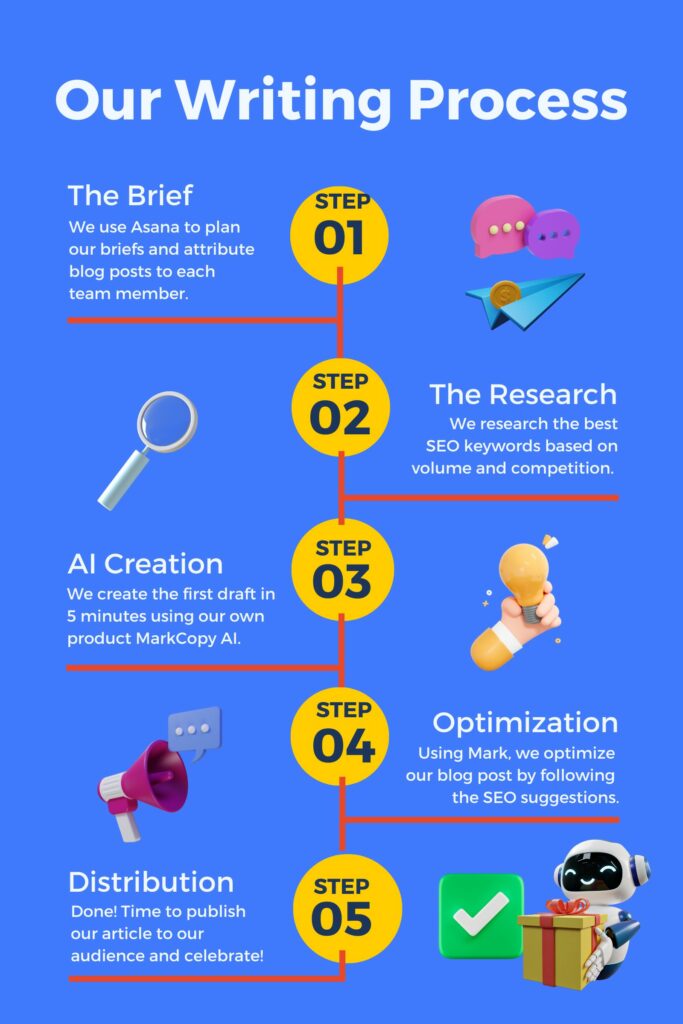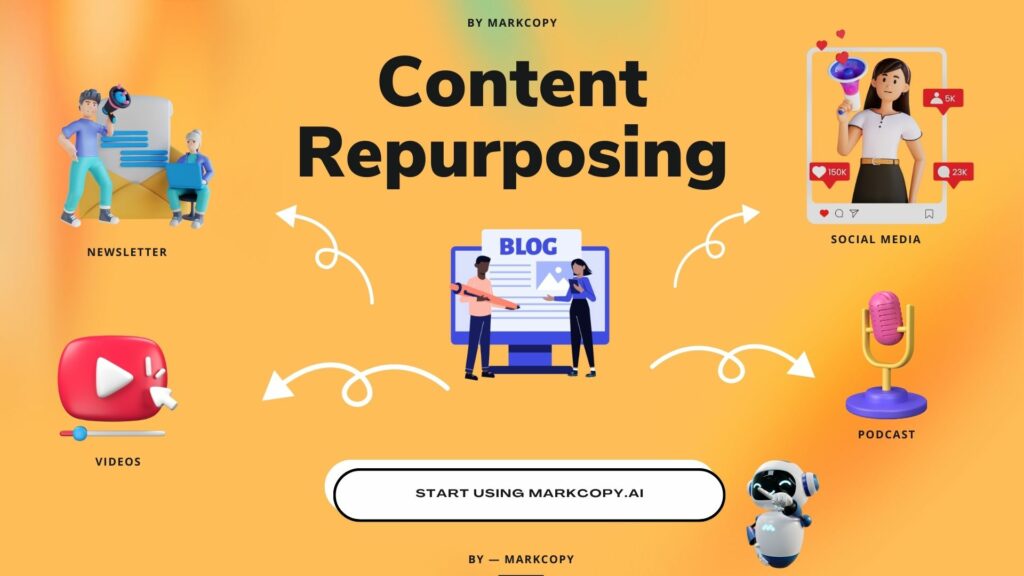Writing a blog is a great way to connect with your customers, prospects, and partners. It also helps you share your expertise, build your brand, and sell a lot of products. All of which directly contribute to your company’s success.
At Mark Copy AI we have been working on our blog since day 1, and it definitely has helped us get traction from the very beginning.
I will be sharing with you how we built a blog that gets thousands of views each month, and how we wrote articles that generated more traffic and leads.
So, what are you waiting for?
Here are 9 steps to make it work. Let’s get started!
Video Walkthrough
1. Start a blog
You can start a blog for free in under 5 minutes. The first thing you will need is a domain name and hosting. You will also need to choose the blogging platform you want to use.
At Mark Copy AI we use WordPress. It is, so far, the best CMS you can find if you want to work on your SEO. Having a blog on WordPress will definitely help you get a better rank on the SERP and generate more traffic on your website!

2. Define your blog writing process
The blog writing process is a systematic way of writing a blog post. With the right process you can write blog posts faster. But if you really want to scale your blog writing, you’ll also need the right tools.
There are a bunch of tools able to help you on your productivity. For us, using AI in our writing process was definitely a game changer. We have used it for years and it has helped us write hundreds of articles in a very short time.
You can basically find tools for anything within your writing process. The most important is to understand your needs and your pain points, so you can find the best fit to solve them. It could be a tool to create your marketing process, organize your content creation or analyze your website.
At Mark Copy AI we use Asana to plan the marketing tasks and the blog writing process. We also use many Google tools, such as Google Analytics and Google Search Console, to understand our website metrics and put our efforts where we can get the best results.
We also use our own AI copywriting tool to write basically any of our marketing content. So if you read any of our website, blog or social media content, you are 99% sure it was co create with Mark Copy AI. It help us to be way more productive on the writing process. We can, thus, post way more content than what we could have without AI.
Those are keys to get started the right way on your blog!

3. Select a topic for your blog
There are thousands of blog topics to write about, but you can make your life easier by choosing a specific niche. Blogging about your niche allows you to create content that is more relevant to your readers and lets them know you understand them and their needs.
For example, if you are a social media manager, you could create an entire blog series about Facebook advertising. If you are a fitness instructor, you could create a series of blog posts about how to get in shape before summer.
Choose a topic that you’re passionate about, and write about it. It will be much easier to go through the steps of writing a blog article if you’re excited about your topic, and it will come across in your writing.
Mark Copy AI is a content creation tool, so we decided to write a blog that will help other companies to work on their content marketing. That’s our specialty, and we do it every day, so why not sharing some tips!
Research your topic to gather information and ideas. You can use books, articles, and other sources to learn more about your topic and to find inspiration for your writing.
If you love what you do, it will be easy to blog about it. Your enthusiasm will come through in your writing and readers will connect with your content. You can also write posts to inspire others who are interested in your niche.
4. Plan your blog writing
Blogging is time-consuming and tedious. It’s even more challenging to come up with new, fresh content every single time. If you’re a blogger, you know this very well.
We’ve all been there: in the middle of writing a post, we get stuck, or perhaps we just don’t feel like writing anymore that day. Blogging is an art. It’s fun, but it can be exhausting, too.
It’s hard to plan the content you’re going to create in advance. But it doesn’t have to be that way! You can plan your blog posts in advance and make your blogging life much easier.
Planning is a crucial part of the blogging process. It will allow you to write posts with ease, and it will also save time. The best idea I can give you is to create an editorial calendar that will keep you on track and focused on delivering value to your readers.
Make sure you’re publishing at least one blog post per week, if not more. If you don’t consider blogging an important part of your content strategy, then you’ll end up putting it off. By creating a content calendar, you’ll ensure that you stay on track with your posts. It will keep you on track and focused on delivering value to your readers.
There are many ways to plan your blog posts. You just need to find the one that works best for you.
Usually, before to start writing, my first step is to create an outline for my blog post and I would defnitely recommend doing that. It really helps organize your thoughts and ensure that your post has a clear structure and flow.
5. Create content for your blog
A blog is a great way to communicate, share and create value for your visitors. Blogging allows you to create evergreen content and helps keep your audience engaged with you.
Within the blog writing process, the content creation is a key step if you want to get the best blog post out of it. It is very important to focus on the content you’re creating to deliver quality!
Make sure to create valuable content for your readers. Write blog posts that engage your audience, share information they need and answers questions they want answered.
I would recommend using Google Analytics and Google Search Console to understand who your audience is, how well your content is performing, what people are looking for and where they are coming from.
The number one rule is to write something useful. Instead of just talking about your product or service, create content that provides value to your audience. It can be anything from a how-to article, to a list post, to an infographic.
The more useful content you have, the better. It is basically the most important rule of writing anything online.
Once you’re ready to start your blog post, write an introduction that captures the reader’s attention. Introduce the main points of your post and add a catchy call to action. It will make them want to read the entire blog post.
Then, develop your ideas with supporting details and examples. Be sure to include transitions between paragraphs to make your post easy to read.
Whether you are blogging personally or professionally, the content you write on your blog is a great way to establish yourself or your company as an expert in your field. This way, you can generate more traffic on your website and attract new customers!
6. Proofread your blog post
When you first write a post, it is likely that you will be quite excited to see it published. However, it’s important to proofread your article before you hit the publish button.
You want to do everything you can to make sure that your blog post is easy to read, informative and engaging. A good way to do this is to proofread your blog post before you publish it.
Read through your post carefully to check for spelling and grammar errors, and to make sure that your writing is clear and concise.
Here are some blog writing best practices. Make sure to tick all of them before to make your blog post live:
Check the spelling and grammar
It’s easy to send a blog post straight to your blog and not think about how it will be read. However, spelling mistakes and bad grammar can make your post look unprofessional. If you don’t have an editor on hand, just take a few minutes to read through your post.
Check that your spelling and grammar are correct, especially if you’re not a native speaker. There are a few online tools that can help you check for spelling mistakes, such as Grammarly.
Avoid long sentences
Be sure to break up long sentences into smaller chunks. Rather than writing one huge sentence, try to think about how you can break it up into smaller ones with just one or two sentences.
Short sentences are easier to read and understand than longer ones. In addition, shorter sentences make thepost look less dull, which is a good thing.
Split long paragraphs
On the flip side, be sure to break up long paragraphs into smaller chunks. The same rule applies here. If you’re writing a long paragraph, try to break it up into a few shorter ones. This can make the post easier to read.
It also makes it easier for your readers to find what they’re looking for and easily skim through your post. This is especially important if you’re writing a long blog post on a technical topic that requires some research.
Highlight the key points
Highlight key points in your post using bold and underline formatting. This makes it easier for readers to scan through your post quickly and find what they’re looking for.
Using bold and underlining formatting on key points also makes your text stand out, which looks nicer. It can also be usefull for SEO purpose as bold text using the <strong> tag will be seen as important keywords by Google’s bots.
Use the right tool to write faster
I like to write my articles with AI. It’s a free and simple way to generate a full blog post in 4-clicks, edit it, and collaborate with other team members. I really saw a difference before and after using an AI text generator.
I was used to spend 4 hours writing a full blog post. Now that I use AI, I’m able to get done the same job in less than 15 minutes. It’s crazy!
Keep in mind that after writing with AI, you’ll still need to adjust the text, but after generating your first draft with AI most of the work will be already done.
Writing with AI, I would recommend adding some personal thoughts, your expertise on specific fiels and some pictures, to make the text even more personal. This way, your audience will keep on reading the full blog post!
I used AI to write this article, and I bet you can’t see the difference between my writing and the AI text. When the AI has generated the blog post I wanted, I can edit the text and format it the way that I want it to look.
It’s just a matter of knowing how to use AI the right way and how to guide it with the right AI inputs to get the most accurate generated text. As soon as you’re onboard, you’ll right so much faster and better with AI.
Focus on the right keywords
What are keywords? They are words that give your blog a search engine ranking boost if you use them correctly.
A keyword is a combination of words that a search engine uses to find your website and give it a ranking boost when somebody searches for that particular keyword or phrase.
For example, if I was to search for an SEO expert on Google, the people who wrote a content focusing on this particular keyword will show up on the first page of Google’s search results.
To make it happen and have a good rank on the SERP, you’ll need to optimize your blog posts on the specific keywords you are targeting. To have a better understanding of wich keywords you should focus on to generate traffic on your website, you’ll first need to do a SEO keyword research. There are several tools that can help you do that.
There are many way to optimize your blog writing to serve SEO requirements. If you want to learn more about SEO and how to create an SEO optimised blog article you can check our tutorial series on Mark Copy blog.
Optimize your images for SEO
Images help bring your blog to life and they also help you rank higher on search engines.
In order to optimize your images, you need to use the right keywords in your image title and description. Don’t forget that Google bots are not able to read images as it is not text content. Alt tags are definitely an opportunity to make your picture readable by the Google bots!
7. Publish your blog post
Well done. Your blog post is done!
Once you are satisfied with your post, you can publish it on your blog or on a blogging platform such as WordPress or Blogger.
All you need to do here is to copy and paste the content you just created and import it on your blog and press the publish button.
Don’t forget the scheduling feature. On some CMS, just like WordPress, you can schedule your blog posts. This way you have a blog post ready to ralease on a regular basis and you don’t have to worry about posting the content anymore!
This will help drive traffic and generate leads. Mark Copy blog is our main source for generating new leads and increasing traffic to our website.
8. Promote your blog post
As soon as your blog post is published, the next step is to promote the content and get it in front of as many relevant people as possible.
Share your post on social media and other platforms to help increase its visibility and reach a wider audience. You can also encourage readers to comment on your post and share it with others.
The more people who read your blog post, the more traffic you will receive and the more likely you are to generate leads.
If your blog post is optimized for SEO with the right keywords and structure you’ll also be able to generate organic traffic out of your content. It’s a great opportunity to grow your business and attract new customers.
However, it’s important not to forget that your end goal should always be to produce great content that people want to read.
In any case, make sure you have a strong call-to-action at the end of each blog post. Always ask your readers to do something. You could ask them to leave a comment on your blog, share it on social media, or subscribe on your newlstter.
Don’t forget to include a call-to-action button in your header and footer of each blog post. That’s a key step if you want to convert your blog visitors into paying customers!
9. Recycle your content
At Mark Copy AI, each blog post is the first one step of a entire process. We try to make as much synergy as possible, so we can get the most out of each content.
We write about topics relevant to our industry, and share the best content on many different platform.
We usually use our blog posts to create a newsletter that goes out every week. We also use our blog contents to create social media posts. Don’t forget that some people might follow you on social media but have no idea of your blog posts. That’s why you need to recycle your content!
This strategy helps us saving tones of time in our marketing strategy.

Conclusion
If you have decided to start a blog, you should know that it is a long and hard process. You will not succeed overnight, but you should have patience. Writing a blog is a part of an entire process. If you pursue this goal with your dedication, you will get the expected results. Good luck!

SEO manager @MarkCopy

0 comments